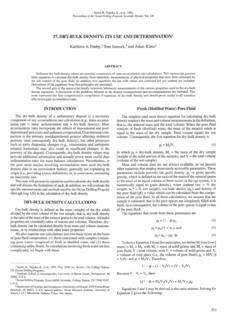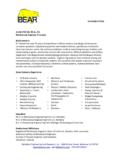Transcription of Shale Stability: Drilling Fluid Interaction and Shale …
1 Copyright 1999, Society of Petroleum Engineers paper was prepared for presentation at the 1999 SPE Latin American and CaribbeanPetroleum Engineering Conference held in Caracas, Venezuela, 21 23 April paper was selected for presentation by an SPE Program Committee following review ofinformation contained in an abstract submitted by the author(s). Contents of the paper, aspresented, have not been reviewed by the Society of Petroleum Engineers and are subject tocorrection by the author(s). The material, as presented, does not necessarily reflect anyposition of the Society of Petroleum Engineers, its officers, or members. Papers presented atSPE meetings are subject to publication review by Editorial Committees of the Society ofPetroleum Engineers. Electronic reproduction, distribution, or storage of any part of this paperfor commercial purposes without the written consent of the Society of Petroleum Engineers isprohibited.
2 Permission to reproduce in print is restricted to an abstract of not more than 300words; illustrations may not be copied. The abstract must contain conspicuousacknowledgment of where and by whom the paper was presented. Write Librarian, SPE, 833836, Richardson, TX 75083-3836, , fax paper presents main results of a Shale stability study,related to the understanding of Shale / Fluid interactionmechanisms, and discusses Shale strength correlation. Themajor Shale / Fluid Interaction mechanisms: Capillary, osmosis,hydraulic, swelling and pressure diffusion, and recentexperimental results are discussed. Factors affecting the shalestrength are discussed, and a sonic compressional velocity-logbased correlation for strength is proposed. Recommendationsfor modeling and improving Shale stability are described,based on the current understanding of Shale make up over 75% of the drilled formations, and over70% of the borehole problems are related to Shale oil and gas industry still continues to fight boreholeproblems.
3 The problems include hole collapse, tight hole,stuck pipe, poor hole cleaning, hole enlargement, plastic flow,fracturing, lost circulation, well control. Most of the drillingproblems that drive up the Drilling costs are related to wellborestability. These problems are mainly caused by the imbalancecreated between the rock stress and strength when a hole isdrilled. The stress-strength imbalance comes about as rock isremoved from the hole, replaced with Drilling Fluid , and thedrilled formations are exposed to Drilling Drilling , Shale becomes unstable when the effectivestate of the stress near the drilled hole exceeds the strength ofthe hole. A complicating factor that distinguishes Shale fromother rocks is its sensitivity to certain Drilling constituents,particularly water.
4 Shale stability is affected by properties ofboth Shale ( mineralogy, porosity) and of the Drilling fluidcontacting it ( wettability, density, salinity and ionicconcentration). The existence and creation of fissures,fractures and weak bedding planes can also destabilize Shale asdrilling Fluid penetrates them. Drilling fluids can cause shaleinstability by altering pore pressure or effective stress-stateand the Shale strength through Shale / Fluid Interaction . Shalestability is also a time-dependent problem in that changes inthe stress-state and strength usually take place over a period oftime. This requires better understanding of the mechanismscausing Shale instability to select proper Drilling Fluid andprevent Shale basic Shale stability problem can be stated as follows: Shale with certain properties (including strength) normally liesburied at depth.
5 It is subjected to in situ stresses and porepressure, with equilibrium established between the stress andstrength. When drilled, native Shale is exposed suddenly to thealtered stress environment and foreign Drilling Fluid . Thebalance between the stress and Shale strength is disturbed dueto the following reasons: Stresses are altered at and near the bore-hole walls asshale is replaced by the Drilling Fluid (of certain density)in the hole. Interaction of Drilling Fluid with Shale alters its strength aswell as pore pressure adjacent to the borehole wall. Shalestrength normally decreases and pore pressure increases asfluid enters the the altered stresses exceed the strength, shalebecomes unstable, causing various stability related prevent Shale instability, one needs to restore the balancebetween the new stress and strength that influence the effective stress are wellborepressure, Shale pore pressure, far away in situ stresses,trajectory and hole angle, etc.
6 The effective stress at any pointon or near the borehole is generally described in terms of threeprincipal components. A radial stress component that actsalong the radius of the wellbore, hoop stress acting around thecircumference of the wellbore (tangential), axial stress actingparallel to the well path, and additional shear prevent shear failure, the shear stress -state, obtainedfrom the difference between the stress components (hoop -usually largest and radial stress - smallest), should not goabove the shear strength failure envelope. To prevent tensilefailure causing fracturing, hoop stress should not decrease toSPE 54356 Shale stability : Drilling Fluid Interaction and Shale StrengthManohar Lal, SPE, BP Amoco2M. LALSPE 54356the point that it becomes tensile and exceeds the tensilestrength of the controllable parameters that influence the stress-stateare Drilling Fluid , mud weight, well trajectory, and Drilling /tripping practices.
7 For example, radial stress increases withmud weight (wellbore pressure) and hoop stress decreases withmud weight causing mechanical stability problem. The nearwellbore pore pressure and strength are adversely affected bydrilling Fluid / Shale Interaction as Shale is left exposed todrilling Fluid (chemical stability problem).Mechanical stability problem can be prevented by restoringthe stress-strength balance through adjustment of mud weightand effective circulation density (ECD) through Drilling /tripping practices, and trajectory control. The chemicalstability problem, on the other hand, is time dependent unlikemechanical instability, which occurs as soon as we drill newformations. Chemical instability can be prevented throughselection of proper Drilling Fluid , suitable mud additives tominimize/delay the Fluid / Shale Interaction , and by reducingshale exposure time.
8 Selection of proper mud with suitableadditives can even generate Fluid flow from Shale into thewellbore, reducing near wellbore pore pressure and preventingshale strength Subsurface ShaleThe term Shale is normally used for the entire class of fine-grained sedimentary rocks that contain substantial amount ofclay minerals. Sedimentologists find Shale hard to work withsince Shale is fine grained, lacks well-known sedimentarystructure (so useful in sandstones), and readily applicable toolsand models are not available to study Thedistinguishing features of Shale (of interest to oil industry) areits clay content, low permeability (independent of porosity)due to poor pore connectivity through narrow pore throats(typical pore diameters range 3 nm-100 nm with largestnumber of pores having 10 nm diameter), and large differencein the coefficient of thermal expansion between water and theshale matrix constituents.
9 To understand Drilling fluidinteraction with Shale , one must start from basic properties ofin situ Shale ( pre-existing water in Shale , mineralogy,porosity), and then analyze the impact of changes in stressenvironment on the properties of factors affect the properties of Shale buried atvarious depths. The amount and type of minerals, particularlyclay, in Shale decide the affinity of Shale for water. Forexample, Shale with more smectite (surface area - 750 m2/gm)has more affinity for water (adsorbs more water) than illite(surface area - 80 m2/gm) or kaolinite (25 m2/gm). Threedifferent types of water are found associated with clays,although each clay will not contain all of the types. Inter-crystalline water is found in associated with the cationsneutralizing the charge caused by elemental water is present as an adsorbed surface layerassociated with the charges on the clay.
10 The swellingassociated with this type of mechanism occur whensedimentary rocks are unloaded as occurs in Drilling . Boundwater is present in the clay molecule itself as structurallybonded hydrogen and hydroxyl groups which under extremeconditions, temperatures of 600-7000 C, separate from the clayto form free water exists only within the pore space betweenthe grains. The porosity of Shale is normally defined as thepercent of its total volume that water. This value is normallymeasured by drying a known volume of Shale at elevatedtemperature. Porosity then is a measure of free water, osmoticwater and to a lesser extent inter-crystalline water. Chemicallybound water is not measured in this procedure. Properties ofshale and Drilling Fluid / Shale Interaction are stronglyinfluenced by the bound water and to a lesser extent by the of water associated with clay can also be removedusing pressure.





